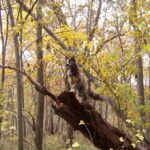by Winding Pathways | Jul 23, 2020 | (Sub)Urban Homesteading, Birds, Garden/Yard, Nature
Chickadee Delight
Guest Blogger Jackie Hull
There is nothing that can surpass the natural ebb and flow of life passing by one’s window every day. The early morning symphony of spring birds creating their own composition of sound as each species awakens to another day. The goldfinches, chipping sparrows, Indigo buntings, robins, flickers, wood thrushes, chickadees, pileated woodpecker, nuthatches, downy and hairy woodpeckers, crows, hawks, catbirds and the unflappable mockingbird all announcing to the world that it’s a new day. Up and at ‘em!”
Grand Symphony
One particular morning after this grand symphony I noticed a chickadee zip into the mimosa tree near the back door. As he teetered on a branch, he seemed to be checking out the birdhouse attached to the side picket fence that surrounds our cottage garden. The chick came in for a closer look as he landed securely on a fence post. Then straight as an arrow, he went through the birdhouse entry for the final inspection.
Apparently the abode met with approval. Soon the male and female chickadees were padding the floor of the birdhouse with moss from the woods across the pasture. Diligently they flew to and from the woods with beaks full of moss. At one point my curiosity coaxed me to peek inside the box to view their progress. The moss-covered the floor and they had begun twining fine grass strands into a circle. One of the chickadees caught me and scolded me soundly for peeking.
Mid-Day Lull
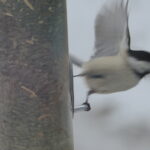
Taking wing
Mid-day that there didn’t seem to be much activity. As soon as the sun began setting, the chicks stepped up their construction. Again my curiosity pushed me to the birdhouse. I opened the door. To my complete delight, I counted six cream-colored eggs with soft brown speckles nestled in a perfectly round cup of grass. Of course, the chicks caught me again and proceeded with another scolding. I retreated to the back step.
Every day I waited impatiently for the hatching. The male came regularly with worms to share with the mate. He would give a clear whistle and then softly chat before he popped into the house. It seemed to me that this breeding process was taking too long. Once more I peeked. Six chicks opened wide their beaks and begged for food. This seemed like the last straw to the doting parents. They clamored about chattering at me. Again I retreated and watched from the back step.
Frantic Fledging
This preparing the chicks for fledging began at dawn and continued until dusk, quite a marathon. First, one adult came with beautiful green worms to be popped into the loudest mouth. The adults always announced that they were coming as they hopped from crepe myrtle to post and always bull’s eyed the doorway. As quickly as they entered, they were gone to forage for more bugs and worms.
One morning several weeks later I noticed a chick teetering in the doorway. The chick quickly retreated because that nosy woman was at the back door again. Sensing I was on the inside looking out, he hopped onto the door lip. Within a matter of minutes, he flew out the doorway, trying desperately to cling to the slippery vinyl house siding. In a twinkling of an eye, one of the adults was there to guide the fledgling to the butterfly bush. The chicks’ tail feathers were a bit short, but using every ounce of energy, the chick followed the adult across the yard into the wild rose bush.
Appreciation of Little Moments
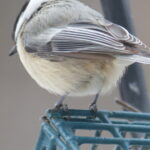
Chickadees grasp suet feeders
This was certainly a morning of the natural ebb and flow of life. If I decided to leave the back doorway, that moment would have passed me by forever. Such a glorious moment I would have missed. Within three hours the other chicks had flown away following their parents into the woods further down the lane. I could hear them chattering to the chicks and the chicks answering them. They have gone on now leaving me to ponder the wonder of life. It was a special event to have had this chickadee pair decide it was just fine to nest so near my back door.
I will always cherish the sheer joy it gave to me.
by Winding Pathways | Jul 16, 2020 | Garden/Yard, Mammals, Pests
What to Do About Raccoons
One June morning we peered out our dining room window to see bird feeder carnage. The shepherd’s hook that holds up suet and seed feeders were bent and the board it was anchored in shattered. The feeders were gone. One we later found in the little pond we have. We were frustrated and a bit angry.
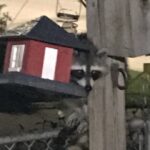
Raccoons are skillful climbers. (Jill photo)
Raccoons were the culprits. Several had raided the night before. Young raccoons are loved everywhere for their “cuteness”. We like them too, but damage can’t be ignored, so we took action.
Amazing Animals
Raccoons are amazingly successful animals. They live nearly everywhere in the continental United States and southern Canada. A few years ago, our son sent us a photo he snapped of a raccoon in a dumpster in our nation’s largest city. They thrive in urban, suburban, and rural areas, especially those that have streams, rivers, or lakes nearby and denning places. Those could be hollow trees, road culverts, or even barns, garages, and house attics.
Raccoons were released in Russia and Japan, where they thrive and are expanding their range. Away from North America they are an invasive species causing ecological problems and probably raiding chicken coops and bird feeders in their new countries.
What do Raccoons Eat?
They are successful, in part, because of their eclectic diet. True omnivores, raccoons enjoy dining on carrion, frogs, crayfish, mice, dog and cat food, birdseed, fruit, and a host of other things, even human food scraps tossed in trash cans.
How We Foil the Raccoons
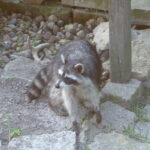
Raccoons forage wherever they find food.
We don’t want to physically harm the raccoons that damaged our bird feeding station so we are doing these things:
- Only put out as much seed as birds eat during the day, so night prowling raccoons find none to munch on. They move on.
- Bring silo, suet and hummingbird feeders inside each evening, so they’re not out to temp nocturnal animals.
- We don’t have a cat or dog but if we did, we would keep their food inside where raccoons cannot get to it.
- We close the sturdy doors that keep raccoons out of our chicken house at night. We’ve also installed heavy wire mesh over the coop’s windows.
- We feed food scraps to our chickens and compost what the hens won’t eat in a “tight” compost bin that raccoons can’t enter. Fortunately, chickens devour the foods raccoons love and shun foods that raccoons also don’t eat. If we had to put food scraps in the garbage, we’d keep the can in the garage where wildlife can’t access it.
Capturing the Culprit
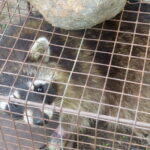
This raccoon readily entered the box trap to eat the sardines.
The night after the raccoons ruined our feeders, we did one other thing. We have a metal box trap that catches, but doesn’t harm, animals. We set it near the feeder with a sardine for bait. A big raccoon went right in. We let him stay there for a while so he could ponder his captivity. Then we sprayed him with water from the hose and opened the trap. He zoomed out like greased lightning, but he may have enjoyed the stay. It was a hot night and the hose water probably cooled him down. We hope he remembers being confined for a short while and stays away.
So far, these actions have worked. Our chickens are healthy and safe. And, no damage to feeders will happen when raccoons prowl.
by Winding Pathways | Jul 9, 2020 | (Sub)Urban Homesteading, Garden/Yard
One morning while watching the arrival of spring migrant birds, we were startled and annoyed to see a cat lurking under the feeder seeking a bird victim. We so enjoy the Summer and Scarlet Tanagers, and Indigo Buntings at our feeders. They add diversity to our usual visitors – titmice, chickadees, cardinals, and woodpeckers who visit throughout the year.
We chased the cat away but began researching the history of domestic cats and their impact on wildlife. It’s both fascinating and concerning.
Challenges Facing Birds
Modern birds face many challenges, including habitat destruction, climate change, light pollution that disrupts navigation, and crashing into towers. However, the International Union for Conservation of Nature lists domestic cats as one of the world’s worst nonnative invasive species. They are the number one human-caused threat to birds in the United States and Canada and kill upwards of 2.4 billion a year.
Domestication of Cats
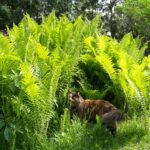
Cats have a strong hunting instinct.
People and cats have a long relationship. They were domesticated from the European wildcat over 10,000 years ago, probably in the Fertile Crescent. Wherever people have migrated to they’ve brought along cats. Even after so many years living with people this animal, Felis sylvestris, retains its predatory instincts, reproduces rapidly, and readily goes wild, or feral.
Domestic cats are fascinating animals loved by millions of people, so any criticism of them often brings a sharp emotional response. However, there’s no doubt they harm wildlife, and one of the main reasons is their artificial high population density.
Animal Territories
Wild predators, like cougars, bobcats, and wolves have vast territories. It takes plenty of land to sustainably produce enough prey for a predator to live. So, if they are crowded together they’d starve. A naturally occurring population of predators in a healthy ecosystem simply has few individuals. For example, a healthy population of native bobcats may have only a few individuals spread over several square miles. The same goes for wild native European wildcats in natural areas in Asia and Europe. The problem comes when humans crowd many cats into a small area.
Families that don’t want cats stalking birds can take a few actions to reduce the death toll of birds. These include:
- Asking neighbors to keep their animals in their home or yard.
- Placing feeders on metal “shepherd’s hooks” that cats can’t climb.
- Configuring a ring of wire mesh around feeding stations to exclude cats from catching juncos, chipping sparrows, and other ground-feeding birds.
Birds face many hazards in this modern world. Cat predation is one that can be reduced. Both cats and birds can enjoy a safer life if the owners of descendants of the European wildcat kept their pets indoors.
by Winding Pathways | Jul 2, 2020 | (Sub)Urban Homesteading, Garden/Yard, Nature
Prairie Seedlings
Tuesday, June 2nd was an exciting day. We walked to our 3,000 square foot patch of dirt that, until recently had been a lawn, and spotted bits of feathery green poking through the dirt. They were baby partridge peas, scattered somewhat evenly through the patch.
Last winter we decided to extend our long-term effort of transforming mowed lawn into the native prairie. In our first blogs, called Prairie Renaissance, we shared why we are doing this, early planning, and ground preparation, and seeding. You can view these on windingpathways.com. This blog tells how we manage our newly planted prairies and some of the tools we use.
Tools for Prairie Management*
*Most tools we bought ourselves. The EGO trimmer we received for testing
By far the most important “tool” for establishing a prairie is Patience. Seed a conventional lawn in the spring and it’s well established that same year. Roll out the sod and the lawn is immediate. Not so with the prairie. It needs time.
When we planted one of our first prairies in the 1980s at the Indian Creek Nature Center Jock Ingels was our mentor. His words ring true. Here’s what he said after advising us to scatter prairie seed on existing bromegrass”Plant those seeds and early next spring burn the grass. Then look carefully. You won’t see any prairie plants and think you wasted your time. Don’t give up. Burn off the grass that autumn or the next spring and watch again. You might see just a few prairie plants that year but still think you’ve wasted your time. But by the third year, the miracle starts. You’ll see more prairie plants, and it will keep getting better and better each year after.”
He was right. Planting a prairie on the existing brome is an exercise in patience. We did it because we had no money for herbicides or ground preparation. For our new prairie at Winding Pathways, we wanted to speed up the process by killing the existing lawn and baring the soil. It’s a “fast” way to start a prairie, but that’s relative. It still takes patience.
Partridge pea is a prairie sprinter. It’s an annual that shows up the first year with its pretty legume yellow bloom. Ours will bloom this summer and, if all goes well, we’ll also have Coreopsis and Black-Eyed Susans soon welcoming bees and butterflies. Newly planted prairies usually bloom with yellow flowers the first few years, while blue and red-toned flowers take longer to establish. So, we expect “yellow” in 2020 and gradually more color and species diversity as the years progress.
Planting a prairie is a little more like planting a tree than a vegetable or conventional flower garden. Patience helps.
Hands-on Tools to Help Manage Our Prairies
- Hand and battery-powered clippers to remove fast-growing weeds.
- We bought a self-propelled power lawnmower – EGO Mower. It’s quiet, effective, and inexpensive to operate.
- A battery-powered string trimmer. This allows cutting weeds higher than most lawnmowers.
- Plant identification books, especially those that have photos of seedlings and butterflies. Many books and websites help identify both prairie plants and weeds as well as insects and spiders. We recently have begun using an app called SEEK, produced by the National Geographic Society and the World Wildlife Fund. It’s free. You snap a photo of the plant, bird, insect, or fungus you want to identify and, presto, most of the time it immediately tells what it is. Many books and online resources help identify mature and blooming plants but seedlings are challenging. An outstanding guide for identifying prairie seedlings is PRAIRIE SEEDLING AND SEEDING EVALUATION GUIDE, which is available by PDF by simply Googling the publication’s name.
-
-
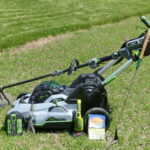
-
We use a variety of tools to manage the emerging prairie.
-
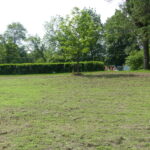
-
By early June a blush of green carpeted the upslope.
-
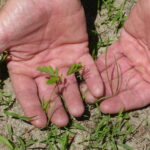
-
Partridge pea is an easy prairie plant to identify.
First Year Prairie Management
Transforming a lawn to a prairie doesn’t eliminate maintenance but it does reduce it. In its first year, a prairie needs special attention. Broadcast prairie seeds on bare ground and soon weeds march right in. In their establishment state prairie plants prioritize root growth over leaves. A rank growth of weeds can snuff them out. Young prairie plants are difficult to identify but generally hug the ground while weeds reach for the sky.
So, for the first two years, we will mow our prairie at the highest height our mower can be set at. This buzzes off the interloping weeds and lets the shorter prairie have sunlight. We’ll mow it three or four times the first year, one or two the second, and then quit mowing altogether once the prairie is established. Sometimes we use our battery-powered string trimmer to cut weeds higher than our lawnmower allows or in places where the ground is rough and the mower doesn’t work well. Future maintenance will involve burning and occasionally clipping out weeds.
Fertilizer and Water
Weeds love fertilizer. Prairie plants don’t need it. There is an irony. Over thousands of years dying prairie plants, especially their roots, created the wonderful topsoil of today’s Corn Belt, yet they do well in poor soil. We never fertilize our prairies. They just don’t need it, and if we did sprinkle some on our plantings the weeds would appreciate it and grow even faster.
The same for water. Prairies are drought tolerant. Their roots penetrate upwards of 15 feet down, drawing water from the subsoil. Watering a prairie mostly helps shallow-rooted weeds. We also completely avoid pesticides and herbicides, with the exception of killing the sod before our initial planting.
A perfect lawn needs infusions of water, fertilizer, and chemicals that stimulate so much growth that frequent mowing is needed. In contrast, a prairie doesn’t need them and, once established, needs little to no mowing.
An Excellent Resource
The Monarch Research Project is doing amazingly good work encouraging people to plant native species that make our world more beautiful and boost populations of beneficial wildlife, especially monarch butterflies. Their website is a host of information and has outstanding webinars on why and how landowners can make our earth a healthier place.
-

-
Black-Eyed Susans are biennials.
-

-
Monarch
-
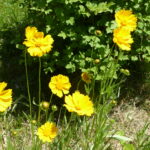
-
By summer we may see Coreopsis.
Our Next Prairie Renaissance blog will be in late summer when we’ll showcase both emerging prairie plants and some of the weeds that bedevil prairies. Later in the fall, a blog will detail prairie prescribed burning.
by Winding Pathways | Jun 25, 2020 | Birds, Garden/Yard, Nature
She feeds ’em. I shoot ’em.
Guest Bloggers STB
Yes, this sounds like a love/hate relationship. But, it is truly pure enjoyment for my wife and me to witness the birds that visit our backyard feeder here in SE Minnesota.
Throughout the year a variety of birds comes from the woods to feast at my wife’s feeder. From late April to early May the orioles make their appearance. Baltimore Orioles have a vivid bright orange color and the Orchard Oriole has a noticeably darker burnt orange color. The recent reality of retirement has allowed us more time for photography and our birds have become a passion.
Capturing a static image of a perched bird is relatively easy but my goal has been to catch them in their interactions and flight. Shutter speeds of 1/1000th of a second or faster are recommended and patience is mandatory but the results might get you hooked. Beware…
-
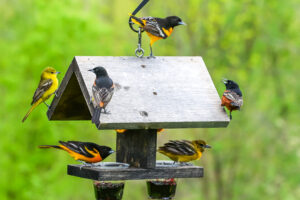
-
The jelly attracts the orioles.
-
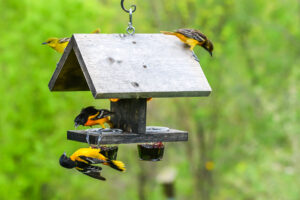
-
Sparring over rights to the jelly.
-
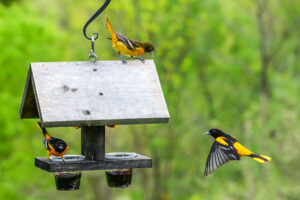
-
Warding off the in-coming oriole.
by Winding Pathways | Jun 18, 2020 | Birds, Garden/Yard, Nature
Another beautiful, blue-sky day. This early morning I am drinking tea and looking out the patio windows. As I enjoy the view of the freshly cut lawn and watch the birds flit about, a bit of busy-ness above the deck catches my attention. A small, loose clump of grey moss trembles and jerks around. It seems suspended like a little tube sock from a maple branch.
A tiny head and two bright eyes appear. In a wink, she’s gone. Moments later, another flash, this time with a hint of yellow. More trembling and jerking around, on the branch. And now I’m sure we have a nesting pair in our tree at the end of the deck.
Despite the yellow, her beak is too long and slender to be a goldfinch. A burst of warbling and I think it might be ‘Mistress Mary’, one of my favourite songbirds that keeps me company on long summer afternoons.
I can look forward to hours of entertainment.
Mistress Mary is just my name for a songbird whose phrases sound like an event organizer ordering people around:
“Jay-jay, sorry, Jo-Jo, sit here.”
“That’s your story?
“So?”
“Bring it here.”
“Will you do it?”
“Where are you?”
“Do ya think?”
She has quite a repertoire of a dozen or so phrases that she repeats faithfully. Fun to listen to. I first heard her about five years ago.
The Hermit thrush has also arrived in Eastern Canada for his summer stay. His ethereal song echoes in the woods.
Readers, scroll through the article in the New York Times to read an interesting article interspersed with bird sounds: Hear 13 Birds Flourishing in a Newly Quiet New York (City).







